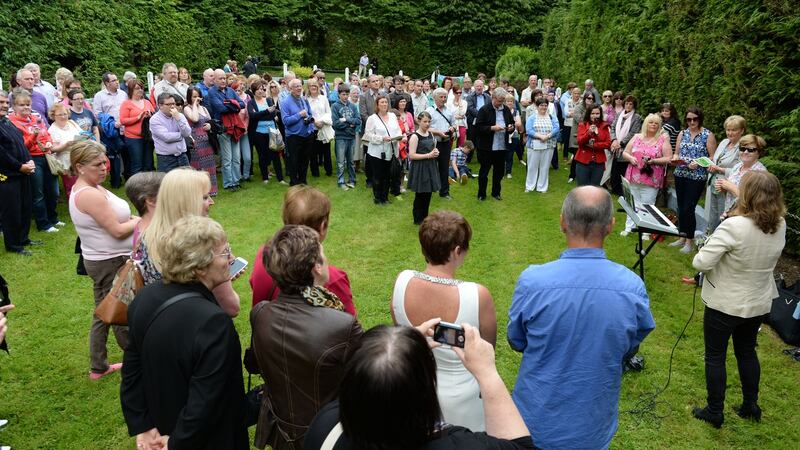A tense negotiation is in prospect as the Government seeks a significant financial contribution from Catholic and Church of Ireland leaders for a new redress scheme for survivors of mother and baby homes.
With the handover of Catholic properties still not complete almost two decades after the original 2002 residential institutions indemnity agreement with church orders, the Government is trying to come up with a mechanism in any new redress deal to ensure swift transfers of money or property. “The State has learned an awful lot of lessons,” one senior official said.
Although some congregations and dioceses have raised many millions of euro in recent years by selling property in surging markets, officials believe others do not have the resources to make a big contribution. The State will still be exposed no matter how much church leaders provide – and the costs are likely to be huge.

Three months have passed since Judge Yvonne Murphy’s mammoth report into the homes. Now crunch time looms as Minister for Children Roderic O’Gorman advances plans for what is termed a restorative recognition scheme. Officials are still working on a proposal. But preliminary indications suggest that up to €1 billion will be required even for “modest redress”, a considerable sum that could well increase if the mounting cost of previous redress schemes is anything to go by.
O'Gorman wrote in January to Catholic leaders Eamon Martin and Diarmuid Martin, Church of Ireland leaders Michael Jackson and Rvd John McDowell and the leaders of six Catholic congregations that ran homes or were linked to the matter: the Bon Secours sisters, the Daughters of Charity of St Vincent de Paul, Sisters of the Sacred Heart of Jesus and Mary, Our Lady of Charity of the Good Shepherd, the Sisters of Mercy, and the Sisters of St John of God. He also wrote to the Legion of Mary, a Catholic lay organisation.
The Minister made clear in those letters that he was seeking money, telling church leaders they may wish to consider “making a contribution to the financial costs” of a redress scheme and other measures. No church figure said in reply that they would not contribute, according to a person familiar with the file, but most did not say whether they would. All have agreed to meet, although that will not happen before officials finish preparations for a scheme, due at the end of this month. Such are the opening gambits in what are likely to be complex talks.
Ageing survivors
The Government wants to move quickly, given the advancing age of many survivors and the need for a decisive political response to a report that cast light on the mistreatment of young women and babies.
But two previous agreements with Catholic orders that were settled in 2002 and 2009 proved to be highly problematic for the State, not least because of controversy over the relatively low €128 million church contribution in the 2002 agreement. Not only were there lengthy delays in the handover of assets, all while redress costs multiplied, but the ultimate combined value of contributions to the State remains far below the levels agreed many years ago.

“The total adjusted offers made by congregations in 2002 and 2009 amount to €436.95 million, of which €239.93 million has been realised to date,” the Department of Education says. “This amounts to approximately 16 per cent of the costs of redress to date, which are estimated to be approximately €1.5 billion.”
Quite what resources are available to religious leaders is not clear from public filings to the Charities Regulator and the Companies Registration Office. But such records, taken together with property market data, provide some insight.
The biggest recent property deal was by the Catholic Archdiocese of Dublin, which sold the former Clonliffe College seminary and adjoining lands to the GAA for €95.5 million.
The 2019 annual financial report of the charities of the archdiocese, published on its website, show that the sale was contracted to take place in four tranches between 2019 and 2022, with the fourth tranche ending in October 2022. The archdiocese received €22.4 million from the deal in 2019 and that transaction was the main factor in the increase in the value of its unrestricted reserves to €34.2 million from €7.6 million.
Tuam home
Charities Regulator data for the Bon Secours sisters, which ran the Tuam mother and baby home, show €14 million in gross income in 2019 and expenditure of €5.5 million. The sisters, who have said they intend to participate in a redress scheme, had gross income €2.4 million in 2018 and expenditure was €8.2 million. They are associated with the Bon Secours hospital group and Bon Secours Trustees, an unlimited company, and received €4.3 million from the group in 2019 for the leasing of buildings. They gave €2.5 million towards the cost of excavation work at the site of the former home in Tuam, believed to be the burial site of hundreds of children.
The regulatory data for the Daughters of Charity of St Vincent de Paul shows their €8.5 million expenditure exceeded €5.2 million income in 2019. The congregation had income of €40.1 million and spent €9.6 million in 2017, the year it sold lands in Blackrock, Co Dublin, for €30 million to Paddy McKillen jnr, a restaurateur and developer.
Charities Regulator data for the Sisters of the Sacred Heart of Jesus and Mary show expenditure of €7.2 million exceeding €2.86 million gross income in the year to March 2020. Companies Office filings show they realised €6.85 million last June from the sale of a property at Bessborough, Cork, site of its former mother and baby home.
Regulator data for Our Lady of Charity of the Good Shepherd shows €3.58 million expenditure in 2019 exceeding €1.5 million gross income. Replying to questions about redress, the Good Shepherd sisters said there was “minimum” criticism in the report of their management of Dunboyne mother and baby home for the local county council. “We were not responsible for adoptions related to the home.”
Data for the congregational leadership of the Sisters of Mercy show €1.57 million in expenditure in 2019 and €1.45 million gross income.
Incomplete as they are, such figures are likely to be closely scrutinised by the Government when it comes to talks on redress. “It’s going to be very hard,” said one person involved in the preparations.









